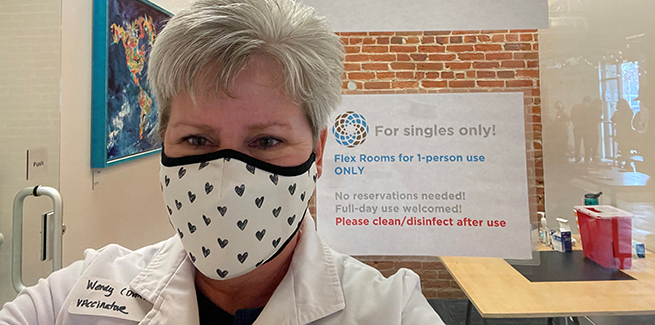Some veterinarians are administering the COVID vaccine. We talked to one of them.

Wendy Hauser, DVM, volunteers at a COVID-19 vaccination site in Denver, Colorado
As of late January, a handful of states—including Colorado, Connecticut, and Nevada—had authorized veterinarians to help human healthcare agencies administer the COVID-19 vaccine.
Those states had to take the initiative—at the time, the federal government hadn’t ruled on the issue. That changed on March 11, when the US Department of Health and Human Services released an amendment to its Public Readiness and Emergency Preparedness Act, which authorized an increase in the pool of qualified professionals able to administer shots (including veterinarians and veterinary students, among others) even if they weren’t authorized to do so by their individual states.
The amendment also provides immunity from liability (except for willful misconduct) for claims should anything go awry during the vaccinations.
As of March 17, the United States Department of Agriculture’s (USDA) Animal and Plant Health Inspection Service (APHIS) had 220 personnel in active deployment around the country, according to USDA spokesperson Joelle Hayden, including 32 veterinarians who are assisting at vaccination sites in Nevada, Maryland, and Oklahoma.
But those veterinarians are federal employees: large-animal veterinarians whose day jobs are largely concerned with the food chain. Companion-animal veterinarians in private practice are still few and far between at vaccination sites.
That’s partly because states have lagged behind.
Kristen Calderon, director of communications for the California Veterinary Medical Association, said California hasn’t authorized veterinarians to administer the COVID vaccine: “There’s been talk, but nothing official.”
Likewise in New York, according to Tim Atkinson, executive director of the New York State Veterinary Medical Society: “New York seems to have enough vaccinators,” he told NEWStat. He said veterinarians have expressed a desire to help, but, so far, the state has made no move to take them up on it.
Wendy Hauser, DVM, had better luck in Colorado, which authorized dentists, optometrists, and veterinarians to administer the vaccine by executive order on January 7.
A former AAHA board member who now represents AAHA in the AVMA House of Delegates, and owner of Peak Veterinary Consulting in Parker, Colorado, Hauser registered to volunteer before the ink on the order was dry.
After undergoing a couple of training sessions (and a background check that included verification of her veterinary license), she was put in a pool of volunteer vaccinators.
But like New York, it turned out Colorado was pretty well supplied with vaccinators already: “They only needed four to six per site, so it’s actually been really competitive to get in there,” Hauser told NEWStat.
She finally got the call a week ago.
Given a choice of vaccination sites to volunteer at, she chose one set up in a community center in the Five Points neighborhood of Denver. Hauser was one of four volunteers on that shift—along with a retired internist, a retired nurse, and a practicing optometrist—and the only veterinarian.
Hauser described the process as extremely well organized, with people showing up in prescheduled blocks of time for their appointments, most with their paperwork already completed. She said the mood was lighthearted, almost festive: “People were just delightful. So many were so excited to get their vaccinations.”
But not everyone. She put uneasy folks at ease by joking about the fact that she was a veterinarian: “I’d tell them, ‘You know, my patients usually don’t wear clothes.’”
And she told one person, a pet owner, that she could always use spray cheese to help them sit still, knowing she’d understand the reference. The woman laughingly declined but told Hauser she’d sit still for chocolate.
In all, Hauser vaccinated around 40 people during her five-hour shift—far fewer than expected, as the goal was 150—and said her veterinary skills came in handy:
“I slightly wiggled the vaccination site like I would with an animal to kind of distract them,” she said. It worked: after the injection, most people would ask whether she was done yet. “They couldn't believe [they’d already gotten] the shot. So I think it works in humans, too.”
Hauser called it great fun and signed up for more volunteer slots, though none have come up yet.
All in all, she says she’s grateful to have had the opportunity to be part of the solution: “My gosh, what a privilege.”



